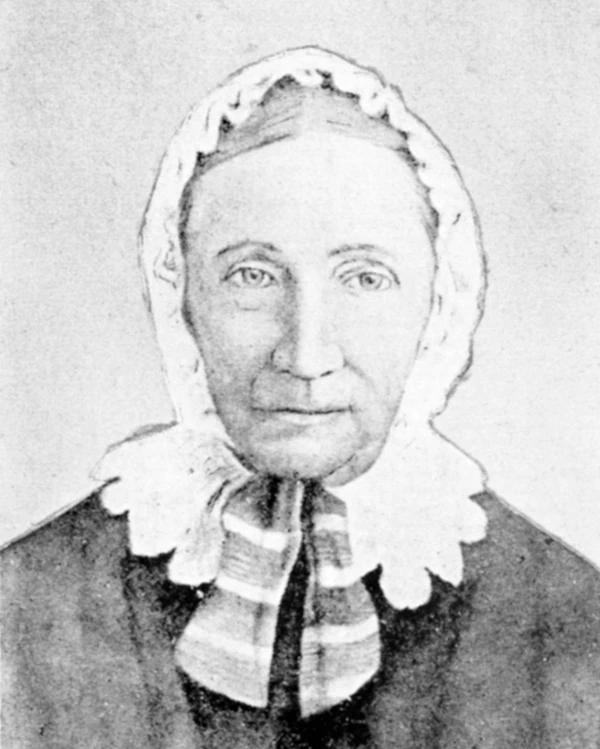Last updated: March 8, 2023
Person
Tabitha Brown

Image/Public Domain
Tabitha Moffat was born 1 May 1780 at Brimfield, Massachusetts, to Dr. Joseph Moffat and his wife, Lois Haynes Moffat. At age nineteen, she married Clark Brown, a minister. They had four children together: Orus, Manthano, John, and, lastly, a daughter named Pherne. After eighteen years of marriage and an assortment of homes across the eastern United States, Clark Brown died; her son John also passed away at the age of six. Clark’s brother, Captain John Brown, retired from the sea and came to live with them. In 1824, the Brown family moved to the St. Charles and Hickory Grove areas—west of St. Louis, Missouri—where Tabitha opened a school.
By the mid-1840s, however, changes were afoot. Tabitha’s oldest son, Orus, returned from the Oregon country in 1845. His lofty descriptions of it convinced his sister Pherne and her husband to accompany him back to Oregon Territory in 1846. Orus also persuaded his uncle to make the trip; he did not, however, invite his mother. Not wanting to be left behind, Tabitha—by then sixty-five years old—packed all her belongings into a wagon and prepared to head west. The party, a caravan of forty wagons, left for Oregon on 15 April 1846 “in high expectation of gaining the wished-for land of promise.”
After Fort Laramie, several wagons led by Orus began to pull ahead, staying separate from Tabitha’s wagon for the remainder of the trip. In August, both wagon trains passed Fort Hall, roughly eight hundred miles from Oregon City. Tabitha’s children and grandchildren, led by Orus, continued west along the main route—“the old road down the Columbia River”—and arrived safely in Oregon via the Barlow Road. However, three or four of the emigrant trains (including Tabitha’s) ended up following a man named Jesse Applegate, who insisted that—if the emigrants followed him—they “would be in settlement long before those who had gone down the Columbia.” Unfortunately, Tabitha wrote, “our sufferings from that time no tongue can tell.” Applegate’s optimism led them into dangerous situations—such as sixty miles of desert without water or grass for their stock. Furthermore, Applegate soon left the travelers, entrusting them to a man named Levi Scott. With his help they reached the Applegate Trail, which led north from California.
Once in Oregon, the ordeal worsened. Tabitha, having lost her wagon, endured a grueling three-day, twelve-mile journey through Oregon’s Umpqua Mountains—passing dead horses, broken wagons, bedding, clothing, and human remains along the way. Eventually, the realization set in that they had to cross the Calapooya Mountains; to make matters worse, winter weather had already arrived and they were short on food. After polishing off her portion of the remaining provisions, Taibtha and Captain John—who was “too old and feeble to render any assistance to me”—saddled their horses and caught up with a wagon train that had left the previous day; however, they lost them again the following day when Uncle John fell from his horse. The wind howled and rain started to fall. She fashioned a tent from a wagon sheet and attempted to “cover [John] as well as [she] could with blankets …expecting he would be a corpse before morning.”
Tabitha Brown woke to the sounds of other emigrants, and half a mile away she saw the wagons that she had tried to catch up to the previous day—carrying fresh venison, no less. A few days later, Tabitha Brown reunited with her children and grandchildren in the Umpqua Valley, near present-day Sutherlin, Oregon. It took the party several days to navigate the next snowy pass. They sent Octavius Pringle, Tabitha’s fourteen-year-old grandson, to fetch provisions for the travelers, and within a week he had returned with food. Before long, however, they “were again in a state of starvation.” A few days later, Orus Brown showed up in their camp with “four pack horses and provisions for our relief”; after reaching the settlements in September, he learned of the suffering of the other emigrants and decided to help. Shortly thereafter, the emigrants left their camp and made a final fifty-mile push to the Willamette Valley.
Brown wrote that “on Christmas day, at 2 P.M. I entered the house of a Methodist minister, the first house I had set my feet in for nine months.” Destitute upon her arrival, Tabitha soon discovered a single coin—a “half-bit” worth just six and one-quarter cents—in an old glove. She soon bought three needles and, after trading some of her old clothes to Indigenous women for deerskin, she began making men’s and women’s gloves. Before long, she had developed a profitable business.
Tabitha spent her first winter in Oregon (1846–47) with the Pringle family in the Salem area, then moved during the following summer to the Astoria area. She spent the next winter in West Tualatin, and—at the urging of her host, Rev. Harvey Clark—she started a boarding school catering to orphans. Clark opened the school in March 1848. By summer, Brown had thirty students; three years later, enrollment had grown to forty. In 1854, Clark and Tabitha Brown founded Pacific University. By that time, Tabitha Brown had purchased a “nicely furnished white frame house on a lot in town” which she rented out for $100 per year. Her hard work had earned her a considerable accumulation of property and livestock on which she collected rents—half of which she donated to the University. In a letter to her family, she marveled at what “I have been able to accumulate by my own industry, independent of my children, since I drew six and a quarter cents from the finger of my glove.” She passed away on 4 May 1858.
(Special thanks to UNM PhD candidate Angela Reiniche for compiling this information.)
